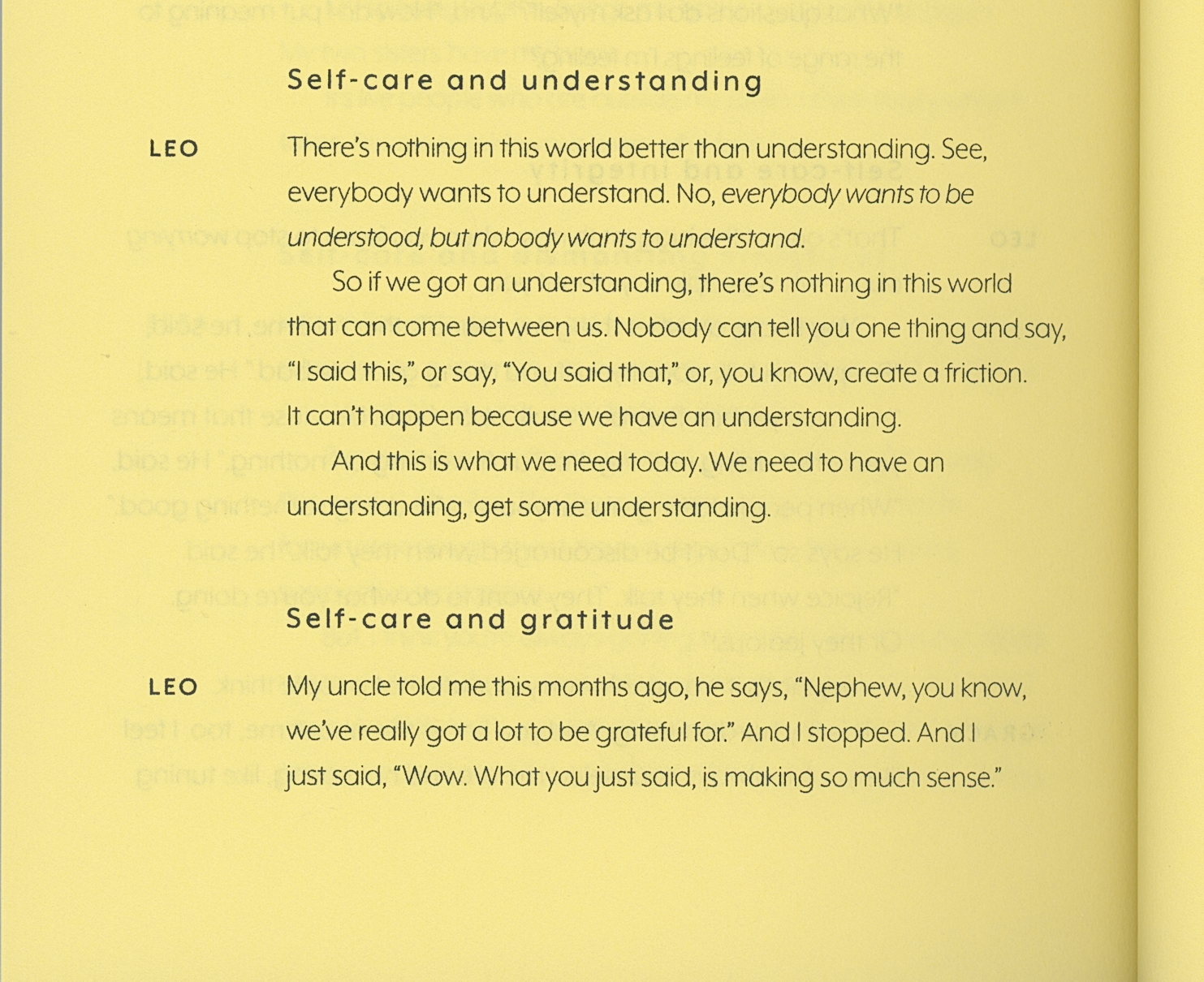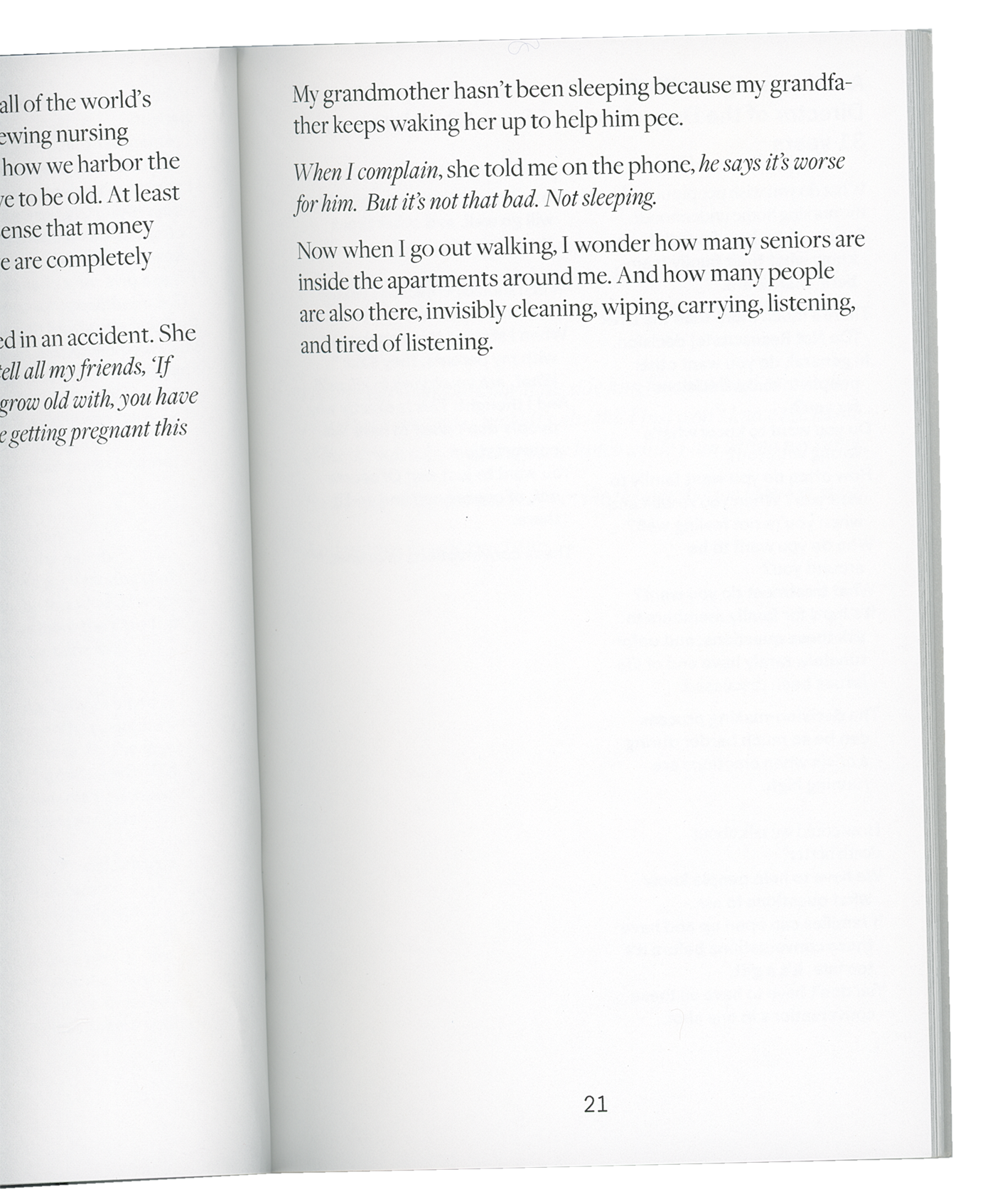[here is a list of some of what we’ve learned about care since we started Thick Press in 2017. Click on each phrase to see related content.]
An Inquiry into Care
the care in cleaning, wiping, carrying, listening, and being tired of listening
the care it takes to understand—because: everybody wants to be understood, but nobody wants to understand
the care in feeling your feelings
the care in validating another
the care you do with your own money, on your own time
the care in welcoming fuzzy conjecture
the care in sharing stories
the care in holding space
***
the care that happens because you showed up limber, you showed up relaxed
the care in performing grief rituals, in leaving space for grieving
the care in honoring collective memory
***
the care that is “green” because it isn’t rooted in extraction
the care in finding your slice of the work in social justice—and then attending to it
the care in radical hospitality
the care in radical accessibility
the care in gettin’ free across levels of systems and time
***
the care and protection that lie beyond critique
the care that’s meant to build power
the care in birthing a new world
the care it takes to grow for the sake of something bigger than us
the care in making beautiful things with others
***
Here is a list of all the books and booklets referenced above.
***
We will be available to chat:
***
Visit our friends at the fair!
the care it takes to understand—because: everybody wants to be understood, but nobody wants to understand
the care in feeling your feelings
the care in validating another
the care you do with your own money, on your own time
the care in welcoming fuzzy conjecture
the care in sharing stories
the care in holding space
***
the care that happens because you showed up limber, you showed up relaxed
the care in performing grief rituals, in leaving space for grieving
the care in honoring collective memory
***
the care that is “green” because it isn’t rooted in extraction
the care in finding your slice of the work in social justice—and then attending to it
the care in radical hospitality
the care in radical accessibility
the care in gettin’ free across levels of systems and time
***
the care and protection that lie beyond critique
the care that’s meant to build power
the care in birthing a new world
the care it takes to grow for the sake of something bigger than us
the care in making beautiful things with others
***
Here is a list of all the books and booklets referenced above.
And here is a list of all planned events.
View Cart
***
We will be available to chat:
Thursday: 10am–3pm EST
Friday: 10am–3pm EST
Saturday: 10am–12pm EST
Sunday: 10am–1pm EST and 3–4pm EST
Please reach out with thoughts, ideas, questions, or special requests. If you have any suggestions for making this page more accessible, please let us know.
***
Visit our friends at the fair!
3 Hole Press
A Published Event
Co-Conspirator Press
Draw Down books
Gato Negro Ediciones
Homie House Press
Impractical Labor (ILSSA) /
Alder & Frankia
Nico Fontana
Passenger Pigeon Press
Press Press
The Southland Institute
Temporary Services/Half Letter Press
Ugly Duckling Press
Wendy’s Subway
A page from the interview series at the end of selfcarefully, by Gracy Obuchowicz, designed and illustrated by Maria Habib.

Self-care and pandemic a new video by Gracy Obuchowicz and Maria Habib author and designer/illustrator of selfcarefully.
In 2018, we published selfcarefully as a “self-helpish” book about caring for yourself. It was a collaboration between a writer/teacher, Gracy, an designer/illustrator, Maria and a small design-oriented press, Thick Press. We wanted to create a book that didn't just explain self-care, but rather made reading it an act of self-care itself.
As we created the book, we tried to follow the sense of energy that was emerging and guiding our creative choices. In our study of Ayurveda, a foundational element of each of our self-care practices, we learned about the concept of prana, or the life force energy that guides us through our lives.
When the illustrations took form, Maria felt that an actual line should start from the beginning and run through each illustration, as a way to bring the many self-care vignettes into one cohesive form. As the drawings emerged, we began to understand the line as a physical representation of the same prana that inspired our work.
Even after the book was published, the prana line wanted to keep going. Maria has made a daily practice of breathing, listening and letting the prana line take form. The line has become a vehicle for feeling grief, integrating experiences, and remembering the ever-present magic of life.
When the illustrations took form, Maria felt that an actual line should start from the beginning and run through each illustration, as a way to bring the many self-care vignettes into one cohesive form. As the drawings emerged, we began to understand the line as a physical representation of the same prana that inspired our work.
Even after the book was published, the prana line wanted to keep going. Maria has made a daily practice of breathing, listening and letting the prana line take form. The line has become a vehicle for feeling grief, integrating experiences, and remembering the ever-present magic of life.
Two social workers in conversation about anti-racism in the context of clinical practice. Erin Segal MSW PhD is the publisher of Thick Press, a collaboration with Julie Cho, a graphic designer. Z., LCSW-C, LICSW is a therapist currently in private practice. Erin and Z., who have been friends for almost 10 years, explore how CURIOSITY may be more fruitful than anti-racism education. They recorded this interview in September of 2020 and edited the transcript together, altering identifying information to protect the confidentiality of the adolescents involved. For added protection of the client, Z. has withheld her name.
ERIN:
I’ve never recorded a socially distant interview before!
Okay, so over the summer, when you and I were talking about anti-racism and social work, you told me a story about an interaction with one of your adolescent clients. You used the phrase, “I got curious,” which got me excited, because I’ve been working with two family therapists, Justine D’Arrigo and Chris Hoff, on a booklet called What happened to curiosity? Do you mind telling me the story again?
Z:
So, back when I was a clinical social worker in a school, I got a referral to see this thirteen-year-old Hispanic kid. The presenting problem was: he’s acting out, he’s being very racist against the Black kids in the school. And I said, “Okay, I’ll see him.”So we met for the first session, and I asked him, “Tell me why you think you’re here.” And, at first, he’s like, “Ummmm,” and as we talked some more, I said, “Well, you know, you were referred to me because you’ve been saying some things against the Black kids in your classroom.” I tried to create a safe space for him, so he could feel comfortable telling me himself what he said or didn’t say.
Anyway, we got to that point in our interaction where I said, “Do you want to tell me—I want to hear from you—what you’ve been saying?”
And he said, “Well, there’s this Black kid and he was talking to me and annoying me. And I told him, ‘I don’t associate with Africans.’” And instead of me also playing the role of the teacher in the school, like, “Well, you’re not supposed to say that, go to the principal’s. . .” You know, my, my role as a therapist was to get curious about that. Okay.
So I said, “Okay. What do you know about “Africans”? Why do you not associate with “Africans”? Tell me a little bit more about it.” And so we were able to have a conversation about what he thinks; you know, “‘Africans’ are this, that”—and I just listened. We really explored that. And he got a chance to process the feelings that he had.
And so after that, there was some room for some education. Because then I asked him about, what do you know about, the history of Black people in this country. And then he told me he knew something about slavery.
And the more we talked about it and the safer he felt with me, he actually said, “You know, I don’t really actually have anything against Black people. I just, I don’t like it when people annoy me.” And I felt like, had he continued to be told, “You’re not supposed to say that,” then his feelings of racism, if that’s what it was, might have increased. But because I got curious with him and I explored his feelings of racism, I feel like he was able to not go there anymore in a genuine way, you know? So, yeah, I’ll never forget that.
It sounds like you connected with him.
When I see a new client, it’s always my priority to start forming a relationship, a strong relationship.
And, you know, I saw the humanity in him immediately. The little broken tooth on his front. And he was kind of big for his age. I don’t think he was going around feeling that hot about himself.
So, I sensed that part of his bullying had to do with the feelings he had about himself. And with what was going on in his home. I can’t remember whether he was undocumented or not, but I know that his mother was undocumented, and he had seen domestic violence.
And you know, there’s also the tension of how minorities in this country are racist against each other.
***
Excerpt of an interview that we posted on Medium.
The conversation between Erin and an anonymous social worker was inspired by our book, emerging, Beyond Critique: Composition and Curiosity in Therapy.
Rachel Kauder Nalebuff reading from her book Stages: On Dying Working and Feeling

